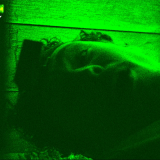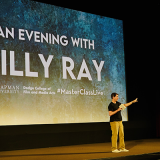Summer Film Academy Visits the Academy Archives on Insightful Field Trip
July 19, 2016
Every summer, Dodge College holds two sessions of the Summer Film Academy, a two-week comprehensive, collaborative, and creative film program for high school students.
For those two weeks, the students are immersed in the world of film through class discussions, film screenings, guest speakers, field trips, and filmmaking in small groups.
Basically, they live, breathe, and eat filmmaking around the clock while being taught by Chapman faculty who are industry professionals. They are also mentored by current Dodge College graduate students and alumni. Their program is culminated at the end of their two weeks by a screening night, where their projects are screened to friends and family in the Folino Theater.
While students usually come from all over the country, from the mid-west to the east coast, for the second session, many came from different parts of the world, such as China and Taiwan.
I was lucky enough to join the second session while they took their field trip to Los Angeles. Their agenda for the day was packed, visiting Warner Bros. Studios, seeing a film at the El Captain, and also, visiting the Pickford Center for Motion Picture Study, part of the Academy of Motion Picture Arts and Sciences.

Students also learned about film restoration.
When the bus arrived, and the students disembarked, one of the very first things they did at the Pickford Center was take a photo with the man himself, the Oscar. While it was blank, and did not belong to anyone in particular, many of the students imaged it was their own.
“I’ve waited my whole life for this moment,” said Kaley M, one of the students attending, as she held the Oscar with a big smile.
Since the group was large, it was split into two. While the first group went off, I stayed with the second group awaiting the tour to begin. While looking at some fantastic behind the scenes photos shot by actor Jeff Bridges, along with many others from classic films over the years, I spoke to a few of the students about why they wanted to come to the Summer Film Academy.
“I have always loved film, and really wanted to learn how to make mine better,” said Milena K, who came in from New York. “The Summer Film Academy has been fun so far, and it’s been a great way to take my own work to the next level.”
“I love how we are learning to collaborate with other people,” said Nathan G. “It kind of forces us to work together, and make the decisions that will make our films better.”
Shortly after that, our tour began, with our guide, Jerry, explaining a bit about the building itself.
It was originally built in 1948, where it had four large sound stages which were used for TV game shows and sitcoms, such as Welcome Back, Kotter. When the studios were done with it, the Academy took it over for their film storage and restoration purposes.

There were plenty of behind the scenes photos to enjoy
Two of the sound stages were converted into theaters. He took us into one, the Dunn Theater, which, at the smaller of the two, only had 300 seats. It was named after pioneering special effects innovator Linwood G. Dunn. The theater itself, though located right next to a busy street, had a deadened sound to it, in order to keep the room silent. It was able to project in 4K digital, 16MM, and 70MM.
“Basically, every film nominated for an Academy Award is screened in here,” said our guide.
“Can I have this in my house?” joked one of the students.
Continuing on the tour, we learned that for every film nominated, the studio behind it also needs to donate a copy to the Academy’s archives. Prior to the 1950s, films were made on nitrate, which looked great when projected, but also very flammable. As a result, the Academy doesn’t have a lot of films pre-1950, since they didn’t have the vaults that were up to code in order to store it, but they are working to fix that now.
In this particular facility, they have two different types of vaults to store films. The first is the unprocessed film vault. This vault is kept at 60 degrees, with 40% humidity, and is considered “short term” storage, even though some films have been in there for years.
While looking in here, students recognized many of the films being stored, such as The Ring, Mighty Joe Young, Con Air, and more.
The cold vault is long term storage, with floor to ceiling storage. There are three stories of storage here, with many of the films reaching back to the late 1800s. This vault is kept at 40 degrees and 50% humidity in order to preserve them.
There are four of these old studios, now converted for storage, all over Los Angeles. However, that’s still not enough, as the Academy is constantly looking for other places to help store their films.

The cold storage vault
The students were amazed to learn that the Academy not only accepts Hollywood films to store, but also home movies, as well! They tend to take in home movies that show an unfiltered view of America life throughout time set in Southern California.
“It’s so cool to literally see the history of film, all right here!” said Jake S.
At the end of the tour, the students bid their goodbyes, and thanked the guides for the insightful tour.
“This definitely gave me something to strive for…to have one of my films in here one day,” said Aman S.
Over all, it was a great learning opportunity for these budding filmmakers, and a wonderful way to start their day in Los Angeles.
While both Summer Film Academy sessions are now over, we expect to see some of those who attended again, both at Dodge College, and with their names on the silver screen.
For more information on the Summer Film Academy, visit our website.


